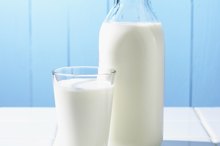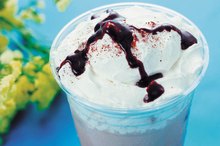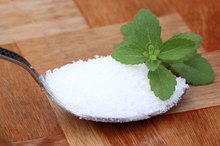What does fact checked mean?
At Healthfully, we strive to deliver objective content that is accurate and up-to-date. Our team periodically reviews articles in order to ensure content quality. The sources cited below consist of evidence from peer-reviewed journals, prominent medical organizations, academic associations, and government data.
The information contained on this site is for informational purposes only, and should not be used as a substitute for the advice of a professional health care provider. Please check with the appropriate physician regarding health questions and concerns. Although we strive to deliver accurate and up-to-date information, no guarantee to that effect is made.
Diabetics and Half-and-Half
Although half-and-half isn't the healthiest dairy option, it isn't necessary for diabetics to avoid this food altogether, especially since it is usually used only in small amounts. As long as they stay within their recommended total carbohydrate and fat intake levels for the day, half-and-half is fine for most diabetics to consume.
Carbohydrate Content
Diabetics should eat a consistent amount of carbohydrates spread throughout the day to help manage their blood sugar levels. Each carbohydrate serving for a diabetic is 15 grams, and diabetics typically need one to two servings per snack and three to five servings per meal. A 2-tablespoon serving of regular half-and-half has slightly over 1 gram of carbohydrates, while the same amount of fat-free half-and-half has twice the carbohydrates at 2.5 grams. Either type should be relatively easy to fit into a meal or snack.
- Diabetics should eat a consistent amount of carbohydrates spread throughout the day to help manage their blood sugar levels.
- A 2-tablespoon serving of regular half-and-half has slightly over 1 gram of carbohydrates, while the same amount of fat-free half-and-half has twice the carbohydrates at 2.5 grams.
Fat Content
Calories & Sugar in Skim Milk
Learn More
Diabetics also need to pay particular attention to the amount of fat they eat because they have an increased risk for heart disease. The American Diabetes Association recommends diabetics get no more than 10 percent of their calories from saturated fats, the type most likely to contribute to heart disease 12. This means about 20 grams per day if you follow a 2,000-calorie diet. A serving of regular half-and-half has about 4 grams of fat, including just over 2 grams of saturated fat. Choose fat-free half-and-half, and you'll only be consuming trace amounts of saturated fat. If you follow a low-fat diet and only use one serving of half-and-half, you may be able to use regular half-and-half while still staying within the recommended fat intake; otherwise, you may want to use the fat-free version. Avoid the flavored versions, as these tend to be higher in sugar and carbohydrates.
- Diabetics also need to pay particular attention to the amount of fat they eat because they have an increased risk for heart disease.
- If you follow a low-fat diet and only use one serving of half-and-half, you may be able to use regular half-and-half while still staying within the recommended fat intake; otherwise, you may want to use the fat-free version.
Glycemic Index
The glycemic index estimates the effect of carbohydrate-containing foods on your blood sugar levels. Foods with a low GI won't have a large effect, but those with a high GI can cause spikes in your blood sugar levels, especially if you eat multiple servings. Dairy products in general tend to fall within the low category with scores of less than 55. This is because both protein and fat help limit the effect of these foods on blood sugar levels and lower their GI. Fat-free half-and-half will have a higher GI than regular because it has a higher carbohydrate content and a lower fat content.
- The glycemic index estimates the effect of carbohydrate-containing foods on your blood sugar levels.
- Foods with a low GI won't have a large effect, but those with a high GI can cause spikes in your blood sugar levels, especially if you eat multiple servings.
Better Alternatives
Butter Substitutes to Improve Cholesterol
Learn More
The American Diabetes Association recommends diabetics get most of their dairy from low-fat or fat-free milk, nonfat light yogurt and plain nonfat yogurt 12. Choosing milk instead of cream or half-and-half will help you keep your fat consumption down and help you save calories. For example, a 2-tablespoon serving of coffee cream has 59 calories and 6 grams of fat, including 4 grams of saturated fat. Switch to whole milk and you'll only be consuming 19 calories and 1 gram of fat. Nonfat milk is the best option, with just 11 calories and 1.5 grams of carbohydrates per 2-tablespoon serving. Both types of milk have low GI scores. Whole milk has a GI of 41 and skim milk has a GI of 32.
- The American Diabetes Association recommends diabetics get most of their dairy from low-fat or fat-free milk, nonfat light yogurt and plain nonfat yogurt 1.
- Nonfat milk is the best option, with just 11 calories and 1.5 grams of carbohydrates per 2-tablespoon serving.
Related Articles
References
Writer Bio
Based in Massachusetts, Jessica Bruso has been writing since 2008. She holds a master of science degree in food policy and applied nutrition and a bachelor of arts degree in international relations, both from Tufts University.









